Email marketing is an extremely effective way to reach your customers and promote products within your e-commerce store.
Consumers like to receive marketing messages through emails, and marketers themselves rate it as a valuable strategy. According to Entrepreneur, 72% of adults in the United States prefer communication with businessesto occur via email, and 73% of businesses report that email marketing is a crucial part of their marketing efforts.
Additionally, according to Capterra, for every $1 that marketers spend on email, they receive an average return of $44.25. And when consumers receive marketing messages via email, they are likely to spend 138% more than the consumers who don’t opt into emails.
If you’re getting started with email marketing, or you want to improve your open and click-through rates, the best approach is to do A/B email split testing. This means that you send out two different versions of your emails and see which one performs better with your subscribers. The one that encourages more people to open it, or to click on the links inside, or to even purchase from you is what you should utilize in future campaigns.
There are a number of ways to do split testing. The following are some ideas to try out, along with tips for ensuring that your emails will convert.
Change your subject line
If your subject line isn’t appealing, your customer won’t open your email. According to MailChimp, your subject line should include a person’s name, and maybe his or her location as well. It’s better to be more personal in the subject lines. You should make sure they’re 50 characters or fewer, so keep them short and to the point. If you’ve been using the same or similar subject lines over and over, you’ll want to vary them so they’re easier to find in a consumer’s inbox.
An example of an excellent subject line comes from CVS Pharmacy. It’s to the point and includes the recipient’s name, as well as a clear reason why they’re emailing.

Try text instead of HTML
Using HTML in your emails allows you to add in pictures, background images, and custom coding. However, some email clients don’t support HTML. Plus, these emails may be slow loading for customers. Customers might not get through an entire email if they’re on their phones and have spotty reception.
Sometimes, plain emails are better than ones with many images and a lot of coding. You can utilize them every so often when you’re sending out a letter from your company, or perhaps a post from your blog. If you use plain text, make sure your emails are easy to read. You should utilize headers, bold fonts for important points, as well as bullets for lists.
If it’s simply a letter, keep it short, like this one from Brooklinen.
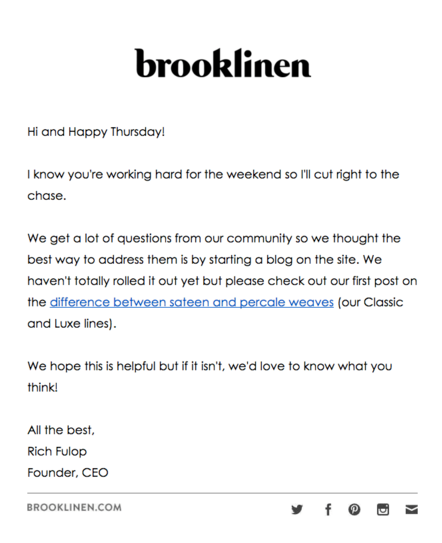
Vary your frequency
Some companies send out emails once a week. Others put them out daily. Aside from letting your subscribers choose how often they receive emails, you should also try sending them more or less frequently depending upon your current strategy.
According to Campaign Monitor, the number one reason that subscribers flag promotional emails as spam is because they receive the emails too often. In a survey of 2,057 adults taken by MarketingSherpa, a majority of people reported that they wanted to see promotional emails at least weekly or at least monthly. However, if you only send out emails once a month, you’re increasing your risk of getting sent to the spam folder automatically. You’ll also have a reputation for being inconsistent.
It’s up to you to decide how frequently to send your emails, and your consumers can decide their preferences when they subscribe to your list. Every email should provide value, which is something you need to keep in mind if you’re sending them out more frequently. You could provide the option to receive a weekly update newsletter, as well as emails when deals come up, for example. As long as the consumer feels like he isn’t being bothered, he’ll stay engaged with your brand.
Switch up the day and time
CoSchedule’s Nathan Ellering looked at 10 studies about the best time to send out emails, and saw that Tuesday is the day that subscribers are most responsive. The second best day is Thursday, followed by Wednesday.
In terms of timing, 10 a.m. was found to be the best time of day. You should follow Eastern Standard Time if you’re a national company in the United States, since 50% of people in the country are in that time zone. However, if you have a local business, go by that time, or by the time zone that most of your subscribers live in.
Include content at the end of a transactional email
Customers are likely to open transactional emails, since they’ll see the details of a recent transaction they made with your company. It’s the perfect opportunity to promote your content and encourage them to become more engaged with your brand. This content can be a blog post, photos from your Instagram page, or a video, for example.
Here’s an example of a transactional email with content from Indiegogo. After a customer pledged to a campaign, he received an email including content for other campaigns at the bottom.
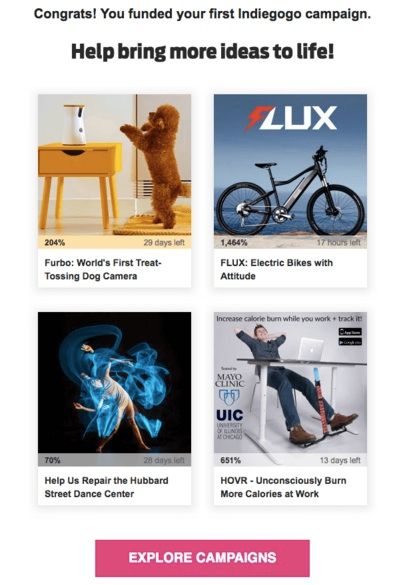
Include many types of content
Right now, you might be sending out emails with one of your blog posts inside. You could test out offering even more content within an email that will be valuable for your customers. You’ll increase the chances of them visiting your website this way, as well as providing them with a variety of content they can choose from.
An example of a brand that is already doing this is One Kings Lane. In one email, they include many different blog posts for subscribers to read. Your audience has varied taste, and will appreciate content that speaks to them.
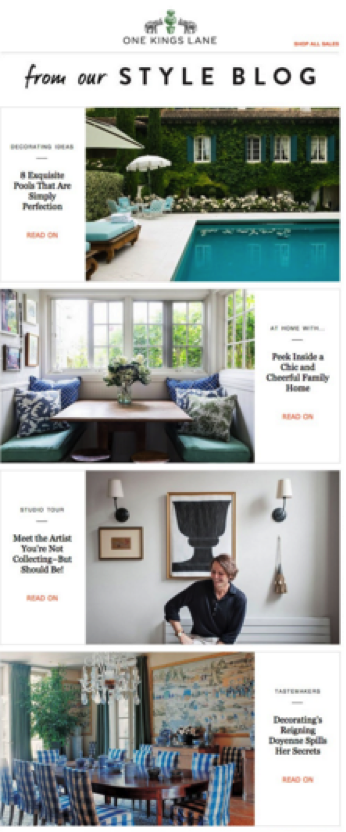
Run a flash sale
Flash sales are going to get new customers to purchase from you. Your existing customers are in your rewards programs or already receive discounts by purchasing from you on a frequent basis.
When you send out flash sale emails to your new subscribers, include a specific subject line, as well as how long the sale is going to be running. In a follow up reminder email, announce that the sale is starting soon and insert the discount code customers need to use to get the deal. You should also use images of some of the items that are on sale to entice them to make a purchase.
Home repair company Serviz will send out coupons and codes, and include when the code expires so that customers act fast and book a repair person.
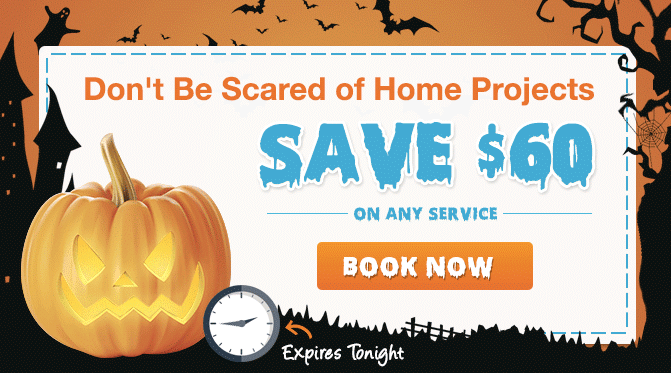
Change your sale offerings
When you send out product emails, you may be writing, “Get 10% off today!” This might be too vague for your customers. It also requires them to do some math. Instead, offer a hard dollar amount, such as $10, or $50 off if they spend a certain amount of money, for example.
For some guidance, take a look at this email from Bed Bath & Beyond, which is specific and tells customers exactly what they need to do to take advantage of the deal.
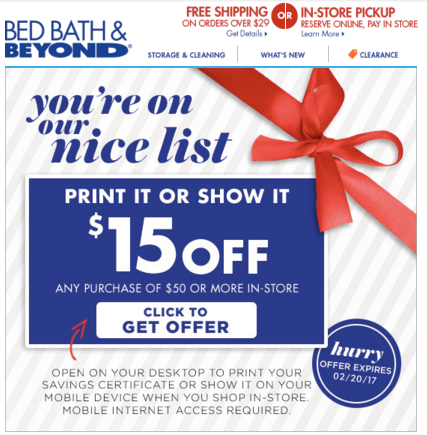
Getting started with testing
By following these guidelines and seeing what’s worked for other companies, you’ll be able to figure out what’s best for your specific needs. Testing is the only way to determine what converts and increases sales for your e-commerce store.
✉️ Get an email when we publish new content:
Don't worry, we won't bug you with junk. Just great content marketing resources.
Ready To Try
Content Harmony?
Get your first 10 briefs for just $10
No trial limits or auto renewals. Just upgrade when you're ready.

You Might Also Like:
- The Wile E. Coyote Approach To Content Guidelines
- Content Brief Templates: 20 Free Downloads & Examples
- The Keyword Difficulty Myth
- How To Find Bottom of Funnel (BoFU) Keywords That Convert
- Bottom of Funnel Content: What Is BOFU Content & 10 Great Examples
- 20 Content Refresh Case Studies & Examples: How Updating Content Can Lead to a Tidal Wave of Traffic 🌊
- How to Create Editorial Guidelines [With 9+ Examples]
- Content Marketing Roles
- How To Write SEO-Focused Content Briefs
- The Content Optimization Framework: [Intent > Topic > UX]
- How To Update & Refresh Old Website Content (And Why)
- 12 Content Marketing KPIs Worth Tracking (And 3 That Aren't)
- 16 Best Content Writing Tools in 2024 (Free & Paid)
- How to Create a Content Marketing Strategy [+ Free Template]
- How To Create Content Marketing Proposals That Land The Best Clients
- What Is A Content Brief (And Why Is It Important)?
- How To Create A Dynamite Editorial Calendar [+ Free Spreadsheet Template]
- How to Use Content Marketing to Improve Customer Retention
- Types of Content Hubs: 5 Approaches & 30+ Examples
- How To Do A Content Marketing Quick Wins Analysis

